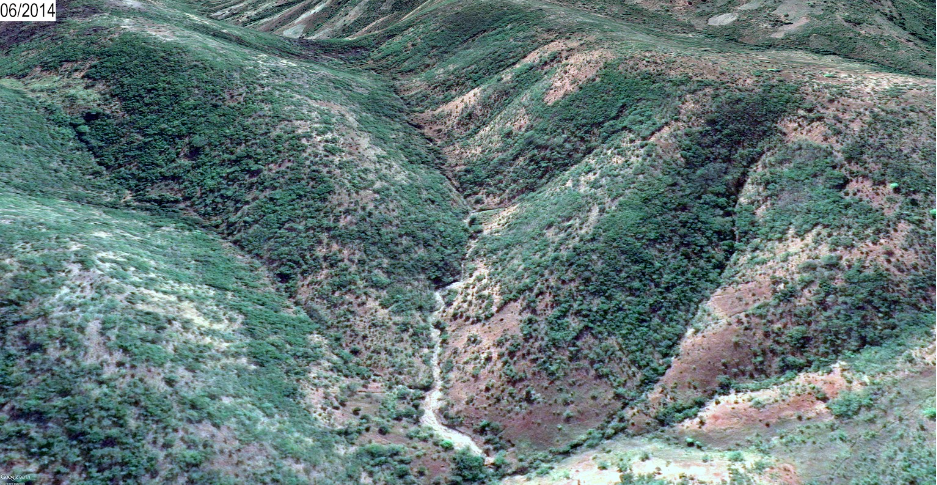
Conservation in Practice with the Jane Goodall Institute
Using the Conservation Standards to manage chimpanzee habitat
First place in the 2016 Case Study Competition
by JGI
The Greater Gombe Ecosystem (GGE) spans an area of 676 km2 along the eastern shore of Lake Tanganyika in Tanzania’s Kigoma region. Comprising Gombe National Park, which was established in 1968, and adjoining community lands, it encompasses 14 villages, stretching from Kigalye in the south to the Burundi border in the north, with Lake Tanganyika forming its western boundary.
Despite its relatively small size, Gombe showcases remarkable biodiversity, boasting a mosaic of habitats, including evergreen and semi-deciduous forests, dense woodlands, open woodlands with Zambesian miombo, grasslands dotted with trees, and upper ridge grasslands with rocky outcrops along the rift escarpment. Notably, Gombe holds the distinction of being the world’s longest continuously studied great ape research site, with Dr. Jane Goodall commencing her groundbreaking studies on wild chimpanzees (Pan troglodytes schweinfurthii) in 1960.
Unfortunately, over the past few decades, significant deforestation and environmental degradation have occurred outside the park boundaries. The resulting habitat loss and fragmentation, coupled with disease threats, have heightened the vulnerability of Gombe’s chimpanzees, making them one of the most endangered wild chimpanzee populations globally. Furthermore, deforestation in the hilly terrain has led to unstable watersheds, causing frequent and severe landslides and flash floods that directly impact local communities’ livelihoods. Scarce water resources and dwindling fuel wood availability have made daily life increasingly challenging for many, and agricultural productivity has suffered due to soil fertility loss from surface run-off.

Kizuka stream flash flood in 2001 that resulted in human casualties and destruction in Mtanga village south of Gombe National Park

Participatory village land use planning. Future forest reserves are marked with leaves.

Village forest monitor using an Android tablets and Open Data Kit app to collect field data and report a tree cut.
To address these challenges, in 1994, the Jane Goodall Institute began working with the local communities and Kigoma District Council to slow and reverse environmental degradation in villages around Gombe National Park through the Lake Tanganyika Catchment Reforestation and Education (TACARE) project. TACARE staff quickly learned that community buy-in was essential for success. Therefore, JGI added agriculture, health, social infrastructure, community development and clean water components to the range of interventions it employed since these elements were the perceived priority needs of the local communities. Addressing those needs increased program credibility and community participation and involvement.
In 2005 JGI started to use Open Standards for Conservation to begin articulating a systematic Conservation Action Plan to guide strategic restoration and maintenance of the region for the benefit of chimpanzees, natural resources and sustainable human livelihoods.
The results and lessons learned from the OS (Open Standards) planning process enabled the Jane Goodall Institute (JGI) and partners to prioritize threats and adapt conservation strategies for the Greater Gombe Ecosystem (GGE). Initially, tree planting and nurseries were considered the main strategies to combat forest and chimpanzee habitat loss due to logging. However, the planning process revealed that incompatible conversion of forests and woodlands to food crops, settlements, and infrastructure development posed more significant threats to chimpanzee habitats outside Gombe. Consequently, a new strategy was devised to develop participatory village land use plans and establish community-managed village forest reserves. These reserves were strategically located using geospatial tools and historical data to create a core conservation area that benefits both human livelihoods and chimpanzee populations. As a result, 13 out of 14 villages completed their land-use plans, designating 9,690 hectares as Village Forest Reserves, covering 68 percent of the priority core conservation area. The engagement with community-based organizations and forest monitoring efforts have led to positive outcomes, including natural regeneration in miombo woodlands and resolving long-standing boundary disputes, contributing to sustainable natural resource management in the region.


Miombo woodland natural regeneration in Kigalye Village Forest Reserve between 2005 (left) and 2014 (right) as detected by the high resolution DigitalGlobe satellite images.
More about the Jane Goodall Institute

The Jane Goodall Institute is a global community conservation organization that advances the vision and work of Dr. Jane Goodall. By protecting chimpanzees and inspiring people to conserve the natural world we all share, they improve the lives of people, animals and the environment. Everything is connected—everyone can make a difference.
Dr. Jane Goodall went into the forest to study the remarkable lives of chimpanzees—and she came out of the forest to save them. When she discovered that the survival of their species was threatened by habitat destruction and illegal trafficking, she developed a breakthrough approach to species conservation that improves the lives of people, animals and the environment by honoring their connectedness to each other.
Download CS
The Conservation Standards is the product of inputs, field tests, and discussions among members of the Conservation Measures Partnership (CMP), which has final editorial authority over the Conservation Standards. Substantial input was also provided by members of the Conservation Coaches Network (CCNet) and other CMP partners.
Photo Credit: Felix Cybulla
Support CS
The biodiversity conservation community is tackling large, complex, and urgent environmental problems where the stakes are high. However, we don’t have a fully functional system to assess the effectiveness of our actions. Without more rigorous measurement of effectiveness and disciplined recording of our efforts, we cannot know or demonstrate that we are achieving desired results.
Photo Credit: Felix Cybulla
Our Collaborators
Every organization, agency, project, and individual has its own preferred set of terms. There is no right answer – the most important thing is that the members of your project team and the people with whom you work have a clear and common understanding of whatever terms you choose to use.
Photo Credit: Chris Scarffe
Contact Us
To inquire about supporting Conservation Standards (CS) or for general inquiries, please contact us at CMPinfo@ConservationMeasures.org
Photo Credit: Nature Conservancy of Canada
